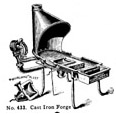| The Wild West and Who Cares! | |||
I got my first and only forge lesson from an old Farmer-type guy named Henry Atkinson from Boscawen NH. At the time he was maybe 75 years old and we were introduced by a common friend named Fred Courser, another great farmer-type and so the lesson progressed. Henry lit a few twigs in the bottom of the forge and placed what he called a bird's nest of newspaper on top and patted a few coke/coals over this and turned the crank a bit and the blower came to life. The fire grew and you could hear the fire crackle. Drifts of coal smoke hung in the shop air and soon a relatively robust heat was ready for work. Henry placed the tip of a chisel into the fire and explained that during the 30s he worked at the quarry sharpening the tools for the rock cutters. A short time later he pulled the chisel from the fire and tapped and shaped it's red tip on the anvil and packed the metal, quenched it in oil for a brief moment, scrapped it on the concrete floor so he could watch the color draw and when the tip came to a very light straw he cooled it in a tub of water.
That was my lesson. Henry had a bottom fired coal forge where the Tuyere is placed in the bottom of the forge and the air blows up and into a pile of coke. So I built myself a very similar one using pipe fittings and the bottom of an old water heater. I adapted a squirrel cage blower to the Tuyere with an air control plate that covered the intake of the blower. Worked great. I found a supply of coal left over from a defunct electrical generating facility. I used that lesson pretty well until I rebuilt that part of my shop and in its place installed sheet metal tools. A short time later I built a gas forge and have been using a version of a gas forge ever since. Coal is great, but wicked dirty. It gets in your nose. The gas is clean and really there is little I can't do with the gas vs. coke. No. 1, below, is a terrific little forge I use all the time for general use. I heat iron/mild steel up, shape it then turn it off. Others like the convenience of this simple gas heat. No. 2 and No. 3 below are also small gas forges made by others. I post these to give you ideas about stuff that works.
|
|||
| The above forges are small, like 1 cubic foot or so. If you want a big forge here is a design of mine that a number of folks have built. |  |
||
| And as usual when you do a little research something new comes to light! I spent my professional life exploring the field of glass making and glass blowing. Forging is a hobby, pure and simple. But along the way when studying the Williamsburg and Eli Whitney forges which I wanted to include in this Forge Section of the web site I found a set of comments and papers by a blacksmith and early iron-making researcher named Lee Sauder. He appears to me to be the real deal and has written about and experimented with early iron/steel making processes in depth. He uses a side blown Tuyere after the style of Williamsburg and Whitney though he has the air moving toward the chimney. Sauder writes about finding an iron Tuyere in the Eli Whitney forge area, partially buried. He recognized it as the key to a successful horizontally fired tuyere forge. I have visited the Whitney Forge myself and so I felt an immediate connection to this work. He has been working with other like-minded smiths for maybe 25 years. They have built bloomery forges and furnaces and an Aristotle furnace for making steel and wrought iron. Look him up. In amongst Lee Sauder's writings is an expressed feeling that the bottom fed Tuyere is a bastardization of the true idea of a forge. I immediately can see his point as this method skews the flame to an oxidized arena filled with clinkers whilst the side fired unit would be a richer work area. making it easier to forge weld. |
|||
